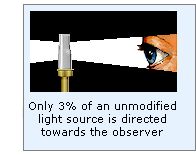 By the middle of the eighteenth century, the "state of the
art" in lighthouse optics consisted of single or multiple whale oil
burning lamps placed in the lantern at the top of a tower. This
method was extremely inefficient, as only three percent of the light
ended up being visible at any given point at sea. The only method
available through which the output of the lamp could be increased was to
increase the size of the flame, thus burning more fuel, and making the
light more labor intensive and costly to operate.
By the middle of the eighteenth century, the "state of the
art" in lighthouse optics consisted of single or multiple whale oil
burning lamps placed in the lantern at the top of a tower. This
method was extremely inefficient, as only three percent of the light
ended up being visible at any given point at sea. The only method
available through which the output of the lamp could be increased was to
increase the size of the flame, thus burning more fuel, and making the
light more labor intensive and costly to operate.
In
1819, the French Government commissioned 34 year old Augustin Jean
Fresnel (pronounced Fruh-nell) to develop an improved lighting system
for French lighthouses. Fresnel was a physicist who was well known for
his experimentation with the theories of light reflection and
refraction. In its simplest form, Fresnel's design was a barrel-shaped array of lenses encircling the light source. In the area immediately horizontal to the light source, dioptric lenses magnified and concentrated the visible light as it passed directly though them. At the same time, above and below the light source, multiple catadioptric prisms mounted around the periphery of the barrel each collected and intensified the light and redirected it in the same plane as the dioptric lenses. With Fresnel's optic array, output was increased dramatically from the old reflector systems, with as much as eighty percent of the light transmitted over twenty miles out to sea.
By rotating the optic array, myriad possibilities of flash patterns could be obtained through the installation of bulls-eye panels around the circumference of the array. Also, by placing colored glass panels in front of the bulls-eyes, a single light could not only be made to flash in a readily identifiable characteristic, but could be made to flash different colors within the sequence. This was a tremendous benefit in situations in which multiple lighthouses were spaced along a shoreline. By providing each with its own signature combination of flash rate and color, not only would the lights warn of obstacles or safe harbor, but mariners could exactly pinpoint their location at night by triangulating against the known location of the lights. Yet another benefit of Fresnels' revolutionary design was its' modular construction. A Fresnel lens could be built in one location, disassembled and easily shipped in multiple small sections, making transportation and re-assembly in the tight confines of a lantern room significantly easier than would have been the case with an optic made up of few huge glass components. Also, the modular nature of the design lent itself to easy modification of characteristic through the insertion of bulls-eye panels and changes in a lenses rotation speed. So revolutionary was Fresnels' design that it was immediately adopted world-wide as the standard lighthouse lens, a pre-eminence that it maintained well into the twentieth century. While August Fresnel saw the rapid adoption of his optic array, he never lived to see it become universally adopted due to his death five years later in 1827.
Of these eleven orders, only the Second, Third, Third and a half, Fourth, Fifth and Sixth Orders were used in the lighthouses of Western Great Lakes. The huge Hyper-Radial, Meso-Radial and First Order lenses were reserved for use in coastal salt water lighthouses, and the smallest Sixth, Seventh and Eighth Order lenses for river and in harbor navigation. Francois Soleil Sr. was the first to build the lenses for Fresnel. His son Francois Jr. took over the work, and continued working in Paris, until he went to St. Petersburg Russia, where he continued to build lenses. Several French companies, all located in the vicinity of Paris were responsible for the manufacture of almost all of the Fresnel lenses used in US lighthouses during the nineteenth century. These companies were: Letourneau & Co, which took over from Francois
Soleil Jr. Eventually, lenses built in accordance with Fresnels' designs were also manufactured in England by the Chance Brothers, and in Germany by Wilhelm Weule. The Macbeth-Evans Company also began manufacturing Fresnel-style lenses in the United States, however relatively few of their lenses were used in the Great Lakes. A number of American companies also manufactured small Fresnel-style lenses for buoys, the most notable of which was the Corning Company. Click here to see a complete listing of the Western Great Lakes lights, and the
lenses with which they were fitted. The Galaxy magazine, Vol VII, 1869 Miscellaneous emails and written correspondences from Thomas A Tag, June 2000. The Keepers Log, Spring 2000 issue, pp 22-27, "The Jewel in the Sand, Thomas A. Tag. |
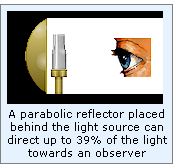 By the beginning of the 19th century, US lighthouse optics
had progressed to the use of a silvered-metal parabolic reflector placed
behind the whale oil lamp, known as the
By the beginning of the 19th century, US lighthouse optics
had progressed to the use of a silvered-metal parabolic reflector placed
behind the whale oil lamp, known as the 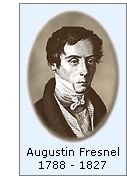 With shipping increasing throughout the world, an optical system was
desperately needed whereby the light could be cast many miles out to
sea, providing ample advanced warning of either danger or safe harbor.
With shipping increasing throughout the world, an optical system was
desperately needed whereby the light could be cast many miles out to
sea, providing ample advanced warning of either danger or safe harbor.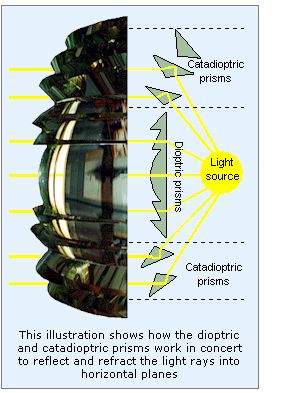 Ignoring the reflector paradigm, Fresnel instead began investigating
ways that glass lenses could be used to concentrate the light source.
Since a single lens of sufficient strength would be too large to be
practical, Fresnel began looking at ways that multiple lenses
surrounding the light source could capture the light rays emitted
from a single light source and direct them into a narrow horizontal beam
Ignoring the reflector paradigm, Fresnel instead began investigating
ways that glass lenses could be used to concentrate the light source.
Since a single lens of sufficient strength would be too large to be
practical, Fresnel began looking at ways that multiple lenses
surrounding the light source could capture the light rays emitted
from a single light source and direct them into a narrow horizontal beam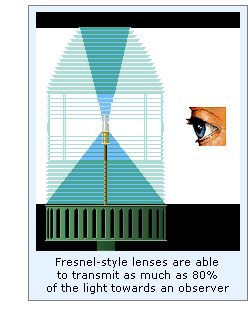 Not surprisingly, this type of optic array quickly became generically
known as the "Fresnel" lens.
Not surprisingly, this type of optic array quickly became generically
known as the "Fresnel" lens.
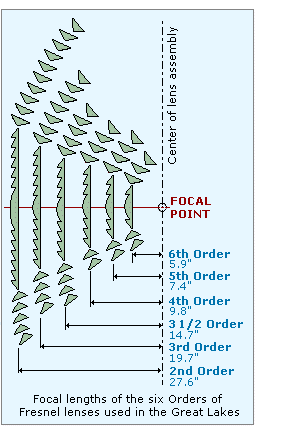 The Fresnel lens design
would eventually be refined into eleven orders, with each order
featuring a standard focal length. Focal length being the distance from
the center of tight source (focal point) to the lens.
The Fresnel lens design
would eventually be refined into eleven orders, with each order
featuring a standard focal length. Focal length being the distance from
the center of tight source (focal point) to the lens.